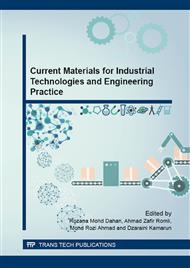p.96
p.103
p.109
p.116
p.123
p.127
p.131
p.138
p.143
Chemical and Thermal Analysis of Silk and Silk-Like Fibres
Abstract:
Natural silk and silk-like synthetic fibres share common external features and ‘hand’ characteristics which cause confusion to end users. Standard chemical tests are the best known technique available but not the most desirable due to the use of chemicals. An alternative technique, thermogravimmetric analysis using a thermogravimmetric analyzer (TGA) is as reliable and is more environmental-friendly. Several fabric samples of natural (silk) and synthetic origin were tested for comparison using the two techniques: TGA and a standard chemical procedure. Bivoltaine and multivoltaine cocoons were used as standards. It was found that all fabric samples tested using TGA agreed with the results obtained from chemical analysis implying the potential of using TGA as an alternative technique to the wet chemical method.
Info:
Periodical:
Pages:
123-126
Citation:
Online since:
December 2015
Authors:
Keywords:
Price:
Сopyright:
© 2016 Trans Tech Publications Ltd. All Rights Reserved
Share:
Citation:


